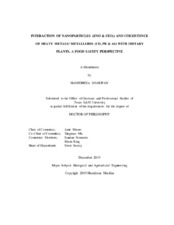| dc.description.abstract | Crops and leafy vegetables are a rich source of protein, essential minerals, and fibers for the human diet, which may turn to toxic plants if exposed to heavy metals or metalloid contamination. Cadmium (Cd), Lead (Pb) and Arsenic (III/V) are extremely toxic elements to humans even at trace concentrations. Elevated levels of such compounds in agricultural soil due to various industrial activities lead to their hyper accumulation in a variety of dietary plant tissues and food products, which raise food safety concerns for consumers. Due to advances in nanotechnology-facilitated agrichemicals, engineered nanoparticles (ENPs) are substantially entering into agricultural systems. Exposure of edible plants with the coexistence of ENPs and heavy metals can alter their uptake and localization of essential minerals such as Fe through different mechanisms. However, the change of this uptake pattern is very critical for the leafy vegetable compared to crops, because of their direct consumption by humans. The goal of this research is to understand the mutual effects of metallic oxide nanoparticles (CeOv2 & ZnO ) and coexisting divalent heavy metals Pb2+ and Cd2+ and metalloids (As(III/V) on their uptake and accumulation as well localization of essential minerals in biological systems of a grain plants, Soybean (Glycine max (L.) Merr.), and four leafy vegetables including Spinach (Spinaciae oleracea), Parsley (Petroselinum sativum),Romaine lettuce (Lactuca sativa L. var. Longifolia), cilantro (Coriandrum sativum)by Romaine lettuce (Lactuca sativa L. var. Longifolia) in soil and hydroponic systems in both pre-harvesting and post-harvesting stages of plant life. At termination, shoots were gently separated from the roots, and the concentrations of Pb, Cd, Fe, Cu, Ce and Zn in all plant tissues were quantified by inductively coupled plasma-mass spectrometry (ICP-MS). In addition, microbial density analysis in the growth media was performed for the treatments in some studies. The last chapter focused on the role of ZnO nanoparticles on the shelf life of tomato (Solanum Lycopersicum). The results will shed light on the role of ENPs on governing the essential elements translocation as well as their key role in alleviating the bioavailability of heavy metals to leafy vegetables and crops which are produced in hydroponics and soil. | en |


